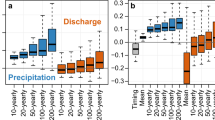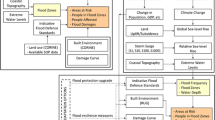Abstract
An approach to considering changes in flooding probability in the integrated assessment of climate change is introduced. A reduced-form hydrological model for flood prediction and a downscaling approach suitable for integrated assessment modeling are presented. Based on these components, the fraction of world population living in river basins affected by changes in flooding probability in the course of climate change is determined. This is then used as a climate impact response function in order to derive emission corridors limiting the population affected. This approach illustrates the consideration of probabilistic impacts within the framework of the tolerable windows approach. Based on the change in global mean temperature, as calculated by the simple climate models used in integrated assessment, spatially resolved changes in climatic variables are determined using pattern scaling, while natural variability in these variables is considered using twentieth century deviations from the climatology. Driven by the spatially resolved climate change, the hydrological model then aggregates these changes to river basin scale. The hydrological model is subjected to a sensitivity analysis with regard to the water balance, and the uncertainty arising through the different projections of changes in mean climate by differing climate models is considered by presenting results based on different models. The results suggest that up to 20% of world population live in river basins that might inevitably be affected by increased flood events in the course of global warming, depending on the climate model used to estimate the regional distribution of changes in climate.
Similar content being viewed by others
References
Adam JC, Lettenmaier DP (2003) Adjustment of global gridded precipitation for systematic bias. J Geophys Res 108(D9):4257
Alcamo J, Leemans R, Kreileman E (eds) (1998) Global change scenarios of the 21st century. Elsevier, Oxford, UK
Alcamo J, Endejan MB, Kaspar F, Rösch T (2001) The GLASS model: a strategy for quantifying global environmental security. Environ Sci Policy 4(1):1–12
Arnell NW (1999a) Climate change and global water resources. Glob Environ Change 9(S1):S31–S49
Arnell NW (1999b) A simple water balance model for the simulation of streamflow over a large geographic domain. J Hydrol 217(3–4):314–335
Arora VK, Boer GJ (2001) Effects of simulated climate change on the hydrology of major river basins. J Geophys Res 106(D4):3335–3348
Berz G (1999) Catastrophes and climate change: concerns and possible countermeasures of the insurance industry. Mitig Adapt Strategies Glob Chang 4(3–4):283–293
Bodo BA (2001a) Monthly discharge data for world rivers (excluding former Soviet Union). Version 1.3, available online at http://dss.ucar.edu/datasets/ds552.1
Bodo BA (2001b) Monthly discharges for 2400 rivers and streams of the former Soviet Union. Version 1.1, available online at http://dss.ucar.edu/datasets/ds553.2
Bronstert A, Niehoff D, Bürger G (2002) Effects of climate and land-use change on storm runoff generation: present knowledge and modelling capabilities. Hydrol Process 16(2):509–529
Bruckner T, Petschel-Held G, Leimbach M, Toth FL (2003) Methodological aspects of the tolerable windows approach. Clim Change 56(1–2):73–89
Cameron D, Beven K, Tawn J (2000) An evaluation of three stochastic rainfall models. J Hydrol 228(1–2):130–149
CIESIN (2000) Gridded Population of the World (GPW), Version 2. Center for International Earth Science Information Network (CIESIN), Columbia University; International Food Policy Research Institute (IFPRI); and World Resources Institute (WRI). CIESIN, Columbia University, Palisades, New York. Available at http://sedac.ciesin.columbia.edu/plue/gpw
Döll P, Kaspar F, Lehner B (2003) A global hydrological model for deriving water availability indicators: model tuning and validation. J Hydrol 270(1–2):105–134
Edmonds J, Pitcher MWH, Richels R, Wigley TML, MacCracken C (1996) An integrated assessment of climate change and the accelerated introduction of advanced energy technologies: an application of MiniCAM 1.0. Mitig Adapt Strategies Glob Chang 1:311–339
Federer CA, Vörösmarty C, Fekete B (1996) Intercomparison of methods for calculating potential evaporation in regional and global water balance models. Water Resour Res 32(7):2315–2321
Fekete BM, Vörösmarty CJ (2004) Uncertainties in precipitation and their impacts on runoff estimates. J Climate 17(2):294–304
Fekete BM, Vörösmarty CJ, Grabs W (1999) Global composite runoff fields on observed river discharge and simulated water balances. Report 22, Global Runoff Data Center
Fekete BM, Vörösmarty CJ, Grabs W (2002) High-resolution fields of global runoff combining observed river discharge and simulated water balances. Glob Biogeochem Cycles 16(3), http://dx.doi.org/10.1029/1999GB001254
Füssel H-M (2003) Impacts analysis for inverse integrated assessment of climate change. PhD thesis, Universität Potsdam
Füssel HM, Toth FL, van Minnen JG, Kaspar F (2003) Climate impact response functions as impact tools in the tolerable windows approach. Clim Change 56(1–2):91–117
Gerten D, Schaphoff S, Haberlandt U, Lucht W, Sitch S (2004) Terrestrial vegetation and water balance – hydrological evaluation of a dynamic global vegetation model. J Hydrol 286(1–4):249–270
Hamon WR (1963) Computation of direct runoff amounts from storm rainfall. Int Assoc Sci Hydrol Publ 63:52–62
Hasselmann K, Hasselmann S, Giering R, Ocana V, Storch Hv (1997) Sensitivity study of optimal CO2 emission paths using a Simplified Structural Integrated Assessment Model (SIAM). Clim Change 37(2):345–386
Hennessy KJ, Gregory JM, Mitchell JFB (1997) Changes in daily precipitation under enhanced greenhouse conditions. Clim Dyn 13(9):667–680
Hipple JD, Drazkowski B, Thorsell PM (2005) Development in the upper Mississippi basin: 10 years after the great flood of 1993. Landsc Urban Plan 72:313–323
Hutchinson MF (1995) Stochastic space–time weather models from ground-based data. Agric For Meteorol 73(3–4):237–264
Johns TC, Carnell RE, Crossley JF, Gregory JM, Mitchell JFB, Senior CA, Tett SFB, Wood RA (1997) The second Hadley Centre coupled ocean–atmosphere GCM: model description, spinup and validation. Clim Dyn 13:103–134
Kharin VV, Zwiers FW (2000) Changes in the extremes in an ensemble of transient climate simulations with a coupled atmosphere–ocean GCM. J Climate 13(21):3760–3788
Kriegler E, Bruckner T (2004) Sensitivity analysis of emissions corridors for the 21st century. Clim Change 66(3):345–387
Kundzewicz ZW, Schellnhuber H-J (2004) Floods in the IPCC TAR perspective. Nat Hazards 31:111–128
Kundzewicz ZW, Graczyk D, Maurer T, Przymusiñska I, Radziejewski M, Svensson C, Szwed M (2004) Detection of change in world-wide hydrological time series of maximum annual flow. WCASP-64, WMO Geneva
Leemans R, Cramer W (1991) The IIASA database for mean monthly values of temperature, precipitation and cloudiness of a global terrestrial grid. Rr-91-18, International Institute for Applied Systems Analysis (IIASA)
Leimbach M, Bruckner T (2001) Influence of economic constraints on the shape of emission corridors. Comput Econ 18:173–191
Li Y, Saxena KML, Cong S (1999) Estimation of the extreme flow distributions by stochastic models. Extremes 1(4):423–448
Liang X, Lettenmaier DP, Wood EF, Burges SJ (1994) A simple hydrologically based model of land surface water and energy fluxes for general circulation models. J Geophys Res 99:14415–14428
Lockwood JG (1999) Is potential evapotranspiration and its relationship with actual evapotranspiration sensitive to elevated atmospheric CO2 levels? Clim Change 41(2):193–212
Lutz W, Sanderson WC, Scherbov S (eds) (2004) The end of world population growth in the 21st century: new challenges for human capital formation and sustainable development. Earthscan, London
Madsen H, Rasmussen PF, Rosbjerg D (1997) Comparison of annual maximum series and partial duration series methods for modeling extreme hydrologic events. 1. At-site modeling. Water Resour Res 33:747–757
Manne AS, Mendelsohn R, Richels RG (1995) MERGE – a model for evaluating regional and global effects of GHG reduction policies. Energy Policy 23:17–34
Meigh JR, McKenzie AA, Sene KJ (1999) A grid-based approach to water scarcity estimates for eastern and southern Africa. Water Resour Manag 13:85–115
Milly PCD, Wetherald RT, Dunne KA, Delworth TL (2002) Increasing risk of great floods in a changing climate. Nature 415:514–517
Mirza MMQ (2002) Global warming and changes in the probability of occurrence of floods in Bangladesh and implications. Glob Environ Change 12(2):127–138
Mitchell TD (2003) Pattern scaling: an examination of the accuracy of the technique for describing future climates. Clim Change 60(3):217–242
Mitchell JFB, Johns TC, Eagles M, Ingram WJ, Davis RA (1999) Towards the construction of climate change scenarios. Clim Change 41(3–4):547–581
Munich Re (2003) Topics-annual review: natural catastrophes 2002
New M, Hulme M, Jones P (2000) Representing twentieth-century space-time climate variability. Part II. Development of 1901–96 monthly grids of terrestrial surface climate. J Climate 13(13):2217–2238
Nijssen B, O’Donnell G, Lettenmaier DP, Lohmann D, Wood EF (2001) Predicting the discharge of global rivers. J Climate 14:3307–3323
Nordhaus WD (1994) Managing the global commons. The economics of climate change. MIT, Cambridge, Massachusetts
Oki T, Nishimura T, Dirmeyer P (1999) Assessment of annual runoff from land surface models using Total Runoff Integrating Pathways (TRIP). J Meteorol Soc Jpn 77:235–255
Österle H, Gerstengarbe F-W, Werner P-C (2003) Homogenisierung und Aktualisierung des Klimadatensatzes der Climate Research Unit of East Anglia, Norwich. In: Proc. 6. Deutsche Klimatagung, Klimavariabilität, pp 326–329
Petschel-Held G, Schellnhuber H-J, Bruckner T, Tóth FL, Hasselmann K (1999) The tolerable windows approach: theoretical and methodological foundations. Clim Change 41(3/4):303–331
Roeckner E, Arpe K, Bengtsson L, Christoph M, Claussen M, Dümenil L, Esch M, Giorgetta M, Schlese U, Schulzweida U (1996) The atmospheric general circulation model ECHAM-4: model description and simulation of present-day climate. Report 218, Max Planck Institute for Meteorology
Rotmans J, de Boois H, Swart RJ (1989) IMAGE: an integrated model to assess the greenhouse effect. Technical Report 758471009, RIVM, Bilthoven, The Netherlands
Russell GL, Miller JR (1990) Global river runoff calculated from a global atmospheric general circulation model. J Hydrol 117:241–254
Tol RSJ (2002) Estimates of the damage costs of climate change. Part I. Benchmark estimates. Environ Resour Econ 21:47–73
Toth FL (2003) Climate policy in light of climate science: the ICLIPS project. Clim Change 56(1–2):7–36
UNESCO (1974) Discharge of selected rivers of the world; a contribution to the International Hydrological Decade, Vol. 5. Unesco, Paris
Voss R, Sausen R, Cubasch U (1998) Periodically synchronously coupled integrations with the atmosphere–ocean general circulation model ECHAM3/LSG. Clim Dyn 14:249–266
Voss R, May W, Roeckner E (2002) Enhanced resolution modelling study on anthropogenic climate change: changes in extremes of the hydrological cycle. Int J Climatol 22(7):755–777
Vörösmarty CJ, Willmott CJ, Choudhury BJ, Schloss AL, Stearns TK, Robeson SM, Dorman TJ (1996) Analyzing the discharge regime of a large tropical river through remote sensing, ground-based climatic data, and modeling. Water Resour Res 32(10):3137–3150
Vörösmarty CJ, Federer CA, Schloss AL (1998) Potential evaporation functions compared on US watersheds: possible implications for global-scale water balance and terrestrial ecosystem modeling. J Hydrol 207(3–4):147–169
Vörösmarty CJ, Fekete BM, Meybeck M, Lammers RB (2000) Global system of rivers: its role in organizing continental land mass and defining land-to-ocean linkages. Glob Biogeochem Cycles 14(2):599–621
Wilby RL, Wigley TML (1997) Downscaling general circulation model output: a review of methods and limitations. Prog Phys Geogr 21(4):530–548
Wilby RL, Wigley TML, Conway D, Jones PD, Hewitson BC, Main J, Wilks DS (1998) Statistical downscaling of general circulation model output: a comparison of methods. Water Resour Res 34(11):2995–3008
Wilks DS, Wilby RL (1999) The weather generation game: a review of stochastic weather models. Prog Phys Geogr 23(3):329–357
Willmott CJ (1982) Some comments on the evaluation of model performance. Bull Am Meteorol Soc 63:1309–1313
Willmott CJ, Matsuura K (2001) Terrestrial air temperature and precipitation: monthly and annual time series (1950–1999). Available online at http://climate.geog.udel.edu/~climate/html_pages/archive.html
Xu C-Y (1999) From GCMs to river flow: a review of downscaling methods and hydrologic modelling approaches. Prog Phys Geogr 23(2):229–249
Author information
Authors and Affiliations
Corresponding author
Additional information
This article is dedicated to the memory of the late Gerhard Petschel-Held. He was an inspiring colleague, as well as a good friend. His sudden departure leaves me deeply shocked, and I am sure he will sorely be missed by all who had the pleasure of meeting him. Thomas Kleinen
Rights and permissions
About this article
Cite this article
Kleinen, T., Petschel-Held, G. Integrated assessment of changes in flooding probabilities due to climate change. Climatic Change 81, 283–312 (2007). https://doi.org/10.1007/s10584-006-9159-6
Received:
Revised:
Accepted:
Published:
Issue Date:
DOI: https://doi.org/10.1007/s10584-006-9159-6




